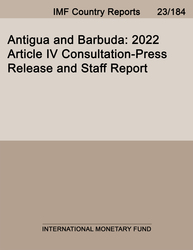
Antigua and Barbuda: 2022 Article IV Consultation-Press Release and Staff Report
Antigua and Barbuda: 2022 Article IV Consultation-Press Release and Staff Report
READ MORE...
Volume/Issue:
Volume 2023
Issue 184
Publication date: May 2023
ISBN: 9798400243240
$20.00
Add to Cart by clicking price of the language and format you'd like to purchase
Available Languages and Formats
| English |
Prices in red indicate formats that are not yet available but are forthcoming.
Topics covered in this book
This title contains information about the following subjects.
Click on a subject if you would like to see other titles with the same subjects.
Economics- Macroeconomics , Money and Monetary Policy , Public Finance , Business and Economics - Statistics , International - Economics , Environmental Economics , Natural Disasters , IMF staff calculation , money market rate , ECCB website , E , C , dollar , response rate , External sector statistics , Natural disasters , Arrears , Global , Caribbean
Also of interest
Summary
Antigua and Barbuda’s economy is on a gradual recovery path, following a sharp contraction in 2020 due to the COVID-19 pandemic. Higher food and fuel prices are adding to inflation, eroding real incomes, and exacerbating fiscal and external imbalances. The economy is projected to grow by 6 percent in 2022 supported by tourism and construction activity, but output will return to pre-pandemic levels only by 2025 due to scarring effects of the pandemic. Inflation is expected to accelerate to 8½ percent in 2022, reflecting the pass-through of global prices to the domestic economy. Continued fiscal consolidation efforts and the growth recovery are bringing down the primary deficit and debt-to-GDP ratio, but gross financing needs are high and arrears continue to be accrued. The financial system has adequate capital and liquidity buffers, with stable NPLs so far, but private sector credit growth is weak. Further commodity price shocks, a sharper-than-expected slowdown in key trading partners, a resurgence of COVID, tighter global financial conditions, lower citizenship-byinvestment revenues, and the ever-present threat of natural disasters all represent material downside risks.
Copyright © 2010 - 2026
Powered by:
AIDC



